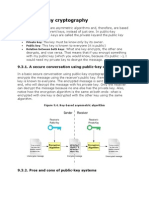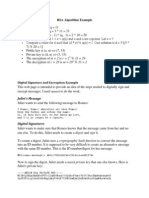Cryptography: Latika Arora, IT/06/321
Cryptography: Latika Arora, IT/06/321
Uploaded by
Yatish TagraCopyright:
Available Formats
Cryptography: Latika Arora, IT/06/321
Cryptography: Latika Arora, IT/06/321
Uploaded by
Yatish TagraOriginal Title
Copyright
Available Formats
Share this document
Did you find this document useful?
Is this content inappropriate?
Copyright:
Available Formats
Cryptography: Latika Arora, IT/06/321
Cryptography: Latika Arora, IT/06/321
Uploaded by
Yatish TagraCopyright:
Available Formats
Cryptography
Latika Arora , IT/06/321
Shri Balwant Institute of Technology Pallri, Sonipat, Haryana it06321.sbit@gmail.com
ABSTRACT The present century has been one of many scientific discoveries and technological advancements. With the advent of technology came the issue of security. As computing systems became more complicated, there was an increasing need for security. Network Security is becoming more and more crucial as the volume of data being exchanged on the Internet increases. Security is a broad topic and covers a multitude of sins. Malicious people trying to gain some benefit, get attention or to harm someone intentionally cause most security problems. Network security problems can be roughly divided into 4 closely intertwined areas. They are: A. Privacy: Privacy means that the sender and the receiver expect the confidentiality. The Transmitted message should make sense to only the intended receiver and to all others it is unintelligible. Authentication: Ensures that the sender and the receiver are who they are claiming to be B. .Data integrity: Ensure that data is not changed from source to destination. C..Non-repudiation: Ensures that the sender has strong evidence that the receiver has received the message, and the
receiver has strong evidence of the sender identity, strong enough such that the sender cannot deny that it has sent the message and the receiver cannot deny that it has received the message. This paper deals with cryptography, which is one of the methods to provide security. It is needed to make sure that information is hidden from anyone for whom it is not intended. It involves the use of a cryptographic algorithm used in the encryption and decryption process. It works in combination with the key to encrypt the plain text. Public key cryptography provides a method to involve digital signatures, which provide authentication and data integrity. I.INTRODUCTION The goal of cryptography is to make it possible that two people to exchange a message in such a way that other people cannot understand. There is no end that number of ways this can be done, but here we will be concerned with the methods of altering the text in such a way that the recipient can undo the alteration and discover the original text.
A.Encryption and decryption
The basic functionality of cryptography is to hide information. Its operation typically includes two processes: Encryption as the process of transforming information so that it is unintelligible to an intruder, and Decryption as the process of
all of todays computing power and available timeeven a billion computers doing a billion checks a secondit is not possible to decipher the result of strong cryptography before the end of the universe. B.How does cryptography work? A cryptographic algorithm, or cipher, is a mathematical function used in the encryption and decryption process. A cryptographic algorithm works in Combination with a keya word, number, or phraseto encrypt the plaintext. The same plaintext encrypts to different cipher text with different keys. The security of encrypted data is entirely dependent on two things: the strength of the cryptographic algorithm and the secrecy of the key. A cryptographic algorithm, plus all possible keys and all the protocols that make it work, comprise a cryptosystem. PGP is a cryptosystem. C.Keys use in cryptography A key is a value that works with a cryptographic algorithm to produce a specific cipher text. Keys are basically really, really, really big numbers. Key size is measured in bits; the number representing a 2048-bit key is huge. In publickey cryptography, the bigger the key, the more secure the cipher text. However, public key size and conventional cryptographys secret key size
transforming the encrypted information so that it is intelligible again. Data that can be read and understood without any special measures is called plaintext or clear text. The method of disguising plaintext in such a way as to hide its substance is called encryption. Encrypting plaintext results in unreadable gibberish called cipher text. We use encryption to make sure that information is hidden from anyone for whom it is not intended, even those who can see the encrypted data. The process of reverting cipher text to its original plaintext is called decryption.
Strong cryptography Cryptography can be strong or weak, as explained above. Cryptographic strength is measured in the time and resources it would require to recover the plaintext. The result of strong cryptography is cipher text that is very difficult to decipher without possession of the appropriate decoding tool. How difficult? Given
are totally unrelated. A conventional 80-bit key has the equivalent strength of a 1024-bit public key. A conventional 128-bit key is equivalent to a 3000-bit public key. Again, the bigger the key, the more secure, but the algorithms used for each type of cryptography are very different. While
the public and private keys are mathematically related, its very difficult to derive the private key given only the public key; however, deriving the private key is always possible given enough time and computing power. This makes it very important to pick keys of the right size; large enough to be secure, but small enough to be applied fairly quickly. Larger keys will be cryptographically secure for a longer period of time. Keys are stored in encrypted form. PGP stores the keys in two files on your hard disk; one for public keys and one for private keys.These files are called key rin gs.If you lose your private key ring you will be unable to decrypt any information encrypted to keys on that ring. D.Types of Cryptography 1.)Public key Crptography Public key cryptography is an asymmetric scheme that uses a pair of keys for encryption: a public key, which encrypts data, and a corresponding private key (secret key) for decryption. It is computationally infeasible to deduce the private key from the public key. Anyone who has a public key can encrypt information but cannot decrypt it. Only the person who has the corresponding private key can decrypt the information. Public-key cryptography is a cryptographic approach which involves the use of asymmetric key algorithms instead of or in addition to symmetric key algorithms. The asymmetric key algorithms are used to create a mathematically related key pair: a secret private key and a published public key. Use of these keys allows protection of the authenticity of a message by creating a digital signature of a message using the private key, which can be verified using the public key. It also allows protection of the confidentiality and integrity of a message, by public key encryption, encrypting the message using the public key, which can only be decrypted using the private key. The primary benefit of public key cryptography is that it allows people who have no preexisting security arrangement to exchange messages securely. The need for sender and receiver to share secret keys via some secure channel is eliminated; all communications involve only public keys, and no private key is ever transmitted or shared. Some examples of publickey cryptosystems are Elgamal, RSA, DiffieHellman and DSA, the Digital Signature Algorithm. 2.)Private key Cryptography Public key cryptography also known as symmetric key cryptography uses a single secret key shared by sender and receiver (which must also be kept private, thus accounting for the ambiguity of the common terminology) for both
encryption and decryption. To use a symmetric encryption scheme, the sender and receiver must securely share a key in advance. The Data Encryption Standard (DES) is an example of a conventional cryptosystem that is widely employed by the U.S. government.
it attests to the contents of the information as well as to the identity of the signer. Digital signatures is basically a message signed with a sender's private key can be verified by anyone who has access to the sender's public key, thereby proving that the sender had access to the private key (and therefore is likely to be the person associated with the public key used), and the part of the message that has not been tampered with.
3.) Digital Signatures A major benefit of public key cryptography is that it provides a method for employing digital signatures. Digital signatures let the recipient of information verify the authenticity of the informations origin, and also verify that the information was not altered while in transit. Thus, public key digital signatures provide authentication and data integrity. A digital signature also provides non-repudiation, which means that it prevents the sender from claiming that he or she did not actually send the information. These feature sare every bit as fundamental to cryptography as privacy, if not more. A digital signature serves the same purpose as a handwritten signature. However, a handwritten signature is easy to counterfeit. A digital signature is superior to a handwritten signature in that it is nearly impossible to counterfeit, plus 4.)Hash Function The system described above has some problems. It is slow, and it produces an enormous volume of dataat least double the size of the original information. An improvement on the above scheme is the addition of a one-way hash function in the process. A one-way hash function takes variable-length input in this case, a message of any length, even thousands or millions of bitsand produces a fixed-length output; say, 160 bits. The hash function ensures that, if the information is changed in any way
even by just one bitan entirely different output value is produced. PGP uses a cryptographically strong hash function on the plaintext the user
electronic information against threats from a variety of potential attackers. Public key cryptography, is the most important technology in modern cryptographic schemes to address issues like key management, authentication, non-repudiation and digital signature cryptosystems with smaller key lengths offer virtually no security. Symmetric-key systems offer an advantage over the public-key systems. Private keys in public-key systems are much larger. III.REFERENCES i. Cryptography and Network Security,
is signing.
This generates a fixed-length data item known as a message digest. Then PGP uses the digest and the private key to create the signature. PGP transmits the signature and the plaintext together. Upon receipt of the message, the recipient uses PGP to recompute the digest, thus verifying the signature. PGP can encrypt the plaintext or not; signing plaintext is useful if some of the recipients are not interested in or capable of verifying the signature. As long as a secure hash function is used, there is no way to take someones signature from one document and attach it to another, or to alter a signed message in any way. The slightest change to a signed document will cause the digital signature verification process to fail. Digital signatures play a major role in authenticating and validating the keys of other PGP users.
Principles and Practices --- (Third Edition)-William Stallings. ii. A Method for obtaining Digital Signatures
and Public Key Cryptographic Systems. ---Rivesp.R , Shamir.A and Adleman.L
II.CONCLUSION As the proverb says that Even a crow can peck an elephant which is stuck in the mud. Even though we are providing high security by cryptography there are many pitfalls in it also. Nothing in the world is 100% secured. Cryptography is one of the way to provide network security but it is not only the path to achieve network security. There is no gain saying the fact that cryptography plays an essential role in protecting the privacy of
iii.
Multiuser Cryptography Techniques. --
Diffie.W and Hellman.M
You might also like
- Cryptography Full ReportDocument9 pagesCryptography Full ReportSushant SharmaNo ratings yet
- Assignment 2 - Part 2 - CryptographyDocument11 pagesAssignment 2 - Part 2 - CryptographyPJ1988No ratings yet
- Network Security & Cryptography: LITAM QUEST - 2007Document13 pagesNetwork Security & Cryptography: LITAM QUEST - 2007api-19799369No ratings yet
- Network Security & Cryptography: Litam Quest-2K7Document13 pagesNetwork Security & Cryptography: Litam Quest-2K7api-19799369No ratings yet
- Cryptography The Art of Secret Writing: SRKR Engineering College BhimavaramDocument12 pagesCryptography The Art of Secret Writing: SRKR Engineering College BhimavaramKondapalli SandeepNo ratings yet
- Security and CryptographyDocument9 pagesSecurity and CryptographyRavi Kumar KNo ratings yet
- Cryptography & Network SecurityDocument5 pagesCryptography & Network SecurityAlok ShuklaNo ratings yet
- SohaiDocument16 pagesSohaiJHON ANDREI SEMANo ratings yet
- Networks Internet E-Commerce Mobile Telephones Wireless Microphones Wireless Intercom Bluetooth Automatic Teller MachinesDocument6 pagesNetworks Internet E-Commerce Mobile Telephones Wireless Microphones Wireless Intercom Bluetooth Automatic Teller MachinessufiyanamujawarNo ratings yet
- Lecture 1.1 Introduction Cryptography-UpdatedDocument7 pagesLecture 1.1 Introduction Cryptography-UpdatedNurdin YussufNo ratings yet
- Encryption SaowaphakDocument12 pagesEncryption SaowaphakSaow AphakNo ratings yet
- IS AssignmentDocument24 pagesIS Assignmentyuvanpgr-wm20No ratings yet
- TCIL-IT Ethical Hacker Assignment No. 2Document11 pagesTCIL-IT Ethical Hacker Assignment No. 2anon_611052707No ratings yet
- Data Encryption DecryptionDocument60 pagesData Encryption DecryptionMohit Sharma100% (2)
- Cryptography 1Document4 pagesCryptography 1timothyokpalao9No ratings yet
- Major Doc Fine1Document75 pagesMajor Doc Fine1Anil SagarNo ratings yet
- Networksecurity & Cryptography: Bandari Srinivas Institute of TechnologyDocument10 pagesNetworksecurity & Cryptography: Bandari Srinivas Institute of TechnologyGirish Kumar DamodaranNo ratings yet
- Cryptography and Its Types and StenographyDocument4 pagesCryptography and Its Types and StenographySaloni ChaudharyNo ratings yet
- Cns Unit-1Document39 pagesCns Unit-1radhikakummari7No ratings yet
- E-Voting Using PGPDocument18 pagesE-Voting Using PGPprvigneshkumarNo ratings yet
- Cryptography: Hiding The WordDocument18 pagesCryptography: Hiding The WordNiharika BundelaNo ratings yet
- Cryptography Is The Art of ProtectiDocument3 pagesCryptography Is The Art of Protectianitagyimah029No ratings yet
- Information SecurityDocument11 pagesInformation Securitys_asmathNo ratings yet
- Hackers Are Commonly Thought of As The Bad Guys, The People Who Make Your Computer Go As SlowDocument7 pagesHackers Are Commonly Thought of As The Bad Guys, The People Who Make Your Computer Go As Slowutsav_8710No ratings yet
- Network Security Using CryptographyDocument11 pagesNetwork Security Using CryptographySheema HazariNo ratings yet
- Unit 2-1Document45 pagesUnit 2-1suryarjun23No ratings yet
- FSS CH-2Document24 pagesFSS CH-2metasebiamerkin7275No ratings yet
- CryptographyDocument8 pagesCryptographySadia Islam ShefaNo ratings yet
- 03-Class-CryptographyPKI-Information SecurityDocument39 pages03-Class-CryptographyPKI-Information SecuritySyeda Insharah RiazNo ratings yet
- Atm MINI PROJECT EDITEDDocument32 pagesAtm MINI PROJECT EDITEDshreyashupare.sits.entcNo ratings yet
- CSE Cryptography ReportDocument21 pagesCSE Cryptography ReportOtunuya Chukwudi Henry EngrNo ratings yet
- Types of CryptographyDocument11 pagesTypes of CryptographyBridget Smith92% (12)
- Introduction To Encryption and Decryption Information TechnologyDocument11 pagesIntroduction To Encryption and Decryption Information TechnologyDeepak NandanNo ratings yet
- Cryptanalysis NotesDocument6 pagesCryptanalysis NotesKarthik G BNo ratings yet
- Cryptography AnswersDocument21 pagesCryptography Answers219 DibyanshuKumarNo ratings yet
- Cryptography in The Banking IndustryDocument8 pagesCryptography in The Banking IndustryArpan KarNo ratings yet
- 27-Chitra G (1) - Desai1, Manisha B. Patil and B. W. GawaliDocument16 pages27-Chitra G (1) - Desai1, Manisha B. Patil and B. W. GawaliPriyanka AbhangNo ratings yet
- Submitted By: A.Irfana Cse-First Year Deepthi Cse-First YearDocument14 pagesSubmitted By: A.Irfana Cse-First Year Deepthi Cse-First YearNiranjan ChandarrajNo ratings yet
- Cryptography and Its TypesDocument2 pagesCryptography and Its TypesSaloni ChaudharyNo ratings yet
- Computer Cryptography: Code - A Set of Information That Will Allow Words To Be Changed To Other WordsDocument5 pagesComputer Cryptography: Code - A Set of Information That Will Allow Words To Be Changed To Other WordsTemitayo OyinNo ratings yet
- Network ch7Document11 pagesNetwork ch7Tesfay GebretsadkanNo ratings yet
- A Seminar ReportDocument39 pagesA Seminar ReportNutan BhorNo ratings yet
- Public Key Infrastructure by Muhedin Abdullahi MohammedDocument123 pagesPublic Key Infrastructure by Muhedin Abdullahi Mohammedshabir AhmadNo ratings yet
- Network Security & Cryptography - Unit-1Document11 pagesNetwork Security & Cryptography - Unit-1Chandrapriya RediexNo ratings yet
- Context of Cryptography: ConfidentialityDocument13 pagesContext of Cryptography: ConfidentialityAnay ShrivastavaNo ratings yet
- CryptographyDocument7 pagesCryptographyDhananjay KumarNo ratings yet
- Cryptography and Network SecurityDocument158 pagesCryptography and Network Securitydineshsai94601No ratings yet
- New Standards For Encryption and Secure Data TransferDocument6 pagesNew Standards For Encryption and Secure Data TransferkumarNo ratings yet
- CryptoDocument36 pagesCryptobipoqihisedeNo ratings yet
- CryptographyDocument19 pagesCryptographyKanimozhiNo ratings yet
- CryptographywordDocument3 pagesCryptographywordRUBENNo ratings yet
- 3.5.1 Asymmetric Keys and Encryption MethodsDocument5 pages3.5.1 Asymmetric Keys and Encryption MethodsNashit BudhwaniNo ratings yet
- Aniket CryptographyDocument16 pagesAniket CryptographyAniket JoshiNo ratings yet
- RSA - Public Key Cryptography Algorithm (Project Id: P12) Karthik Karuppaiya Graduate Student Computer Science Department Arizona State UniversityDocument18 pagesRSA - Public Key Cryptography Algorithm (Project Id: P12) Karthik Karuppaiya Graduate Student Computer Science Department Arizona State UniversityKaran RajNo ratings yet
- Unit 1Document37 pagesUnit 1SutikshanNo ratings yet
- Blockchain Technology NotesDocument44 pagesBlockchain Technology NotesShraddhey Satpute100% (1)
- CryptographyDocument37 pagesCryptographyHarish Kumar0% (1)
- Term PaperDocument5 pagesTerm PaperSai Teja UppuluriNo ratings yet
- 2011-03-Overview of The Microsoft PKI - ADCS 2008 R2-V - 1.02-Fabien - DucheneDocument107 pages2011-03-Overview of The Microsoft PKI - ADCS 2008 R2-V - 1.02-Fabien - DucheneGaganNo ratings yet
- 2023 Data Threat Report Global Edition UslDocument30 pages2023 Data Threat Report Global Edition Uslmefak46208No ratings yet
- Key Management LifecycleDocument55 pagesKey Management LifecycleSherif Salama100% (1)
- Payshield 9000: The Hardware Security Module That Secures The World'S PaymentsDocument2 pagesPayshield 9000: The Hardware Security Module That Secures The World'S PaymentsKarlita AngelicaNo ratings yet
- Ch14: Key Distribution (Computer and Network Security)Document37 pagesCh14: Key Distribution (Computer and Network Security)DinaNo ratings yet
- Enabling Trust and Privacy-Preserving e-KYC System Using BlockchainDocument12 pagesEnabling Trust and Privacy-Preserving e-KYC System Using BlockchainAARTHI SNo ratings yet
- Overview of The Encryption Features For VSP F Series and VSP G SeriesDocument12 pagesOverview of The Encryption Features For VSP F Series and VSP G SeriesHtc HtcNo ratings yet
- X.509 CertificateDocument15 pagesX.509 CertificateShivani ShahNo ratings yet
- OpenSSL+Cheat+Sheet+ +v1.7+ +Practical+Networking+Document2 pagesOpenSSL+Cheat+Sheet+ +v1.7+ +Practical+Networking+juan vargasNo ratings yet
- 9.3.1. A Secure Conversation Using Public-Key CryptographyDocument4 pages9.3.1. A Secure Conversation Using Public-Key CryptographyTanusri GhoshNo ratings yet
- 2.3 Encryption: Symmetric and Asymmetric EncryptionDocument24 pages2.3 Encryption: Symmetric and Asymmetric EncryptionHussain AhmedNo ratings yet
- Is Chep-5Document39 pagesIs Chep-5Dhruv SojitraNo ratings yet
- Public Key Cryptography and RSADocument44 pagesPublic Key Cryptography and RSAManal MustafaNo ratings yet
- Error Details567Document4 pagesError Details567Tạ ĐạtNo ratings yet
- Daniel Yeboah West LA TrasncriptDocument4 pagesDaniel Yeboah West LA TrasncriptDanielNo ratings yet
- Diffie HellmanDocument8 pagesDiffie Hellmanabdulrahim221298No ratings yet
- RSA Algorithm ExampleDocument4 pagesRSA Algorithm ExamplebonbonzinNo ratings yet
- Control Domain Control Title Control ID: Cloud Controls Matrix Version 4.0Document40 pagesControl Domain Control Title Control ID: Cloud Controls Matrix Version 4.0santhosh pavan kumarNo ratings yet
- Mobile App Security Checklist-English 1.2Document65 pagesMobile App Security Checklist-English 1.2xadfasdfNo ratings yet
- Audit Free Cloud Storagevia Deniableattributebased Encryption 1Document11 pagesAudit Free Cloud Storagevia Deniableattributebased Encryption 1vijay kmNo ratings yet
- Master Degree Dissertation ExamplesDocument4 pagesMaster Degree Dissertation ExamplesPayToWriteMyPaperHuntsville100% (1)
- Advances in P25Document96 pagesAdvances in P25JUAN CARLOS ALVAREZ SALAZAR100% (1)
- DLF NCR 1 Security Audit ReportDocument56 pagesDLF NCR 1 Security Audit Reportanon_946063796No ratings yet
- Assignment No 2Document6 pagesAssignment No 2Ammar Ali Abdo MorshedNo ratings yet
- Informatii Privind Contributiile Sociale Si Venit Baza Impozit Conform Datelor Declarate in D112 1720410431515 Stoian N Marian CNPDocument5 pagesInformatii Privind Contributiile Sociale Si Venit Baza Impozit Conform Datelor Declarate in D112 1720410431515 Stoian N Marian CNPMarian StoianNo ratings yet
- Dr. Manik Lal Das: CareerDocument19 pagesDr. Manik Lal Das: CareerNikola MiloševskiNo ratings yet
- Asma 1Document25 pagesAsma 121981a05g6No ratings yet
- Ciphers Withciphers Scan ToolDocument4 pagesCiphers Withciphers Scan Toolrutikakamble87No ratings yet
- X9 Standards CatalogDocument38 pagesX9 Standards CatalogRohit SinghNo ratings yet
- Data Encryption PolicyDocument6 pagesData Encryption PolicyKamrul HasanNo ratings yet

























































































